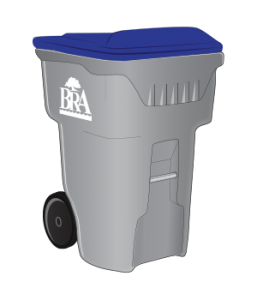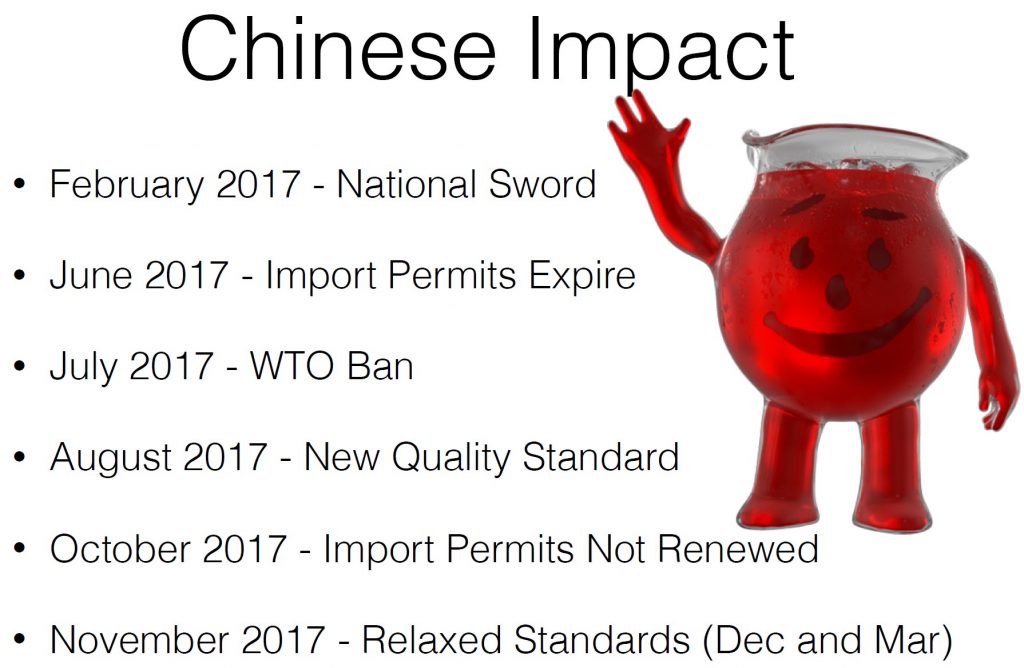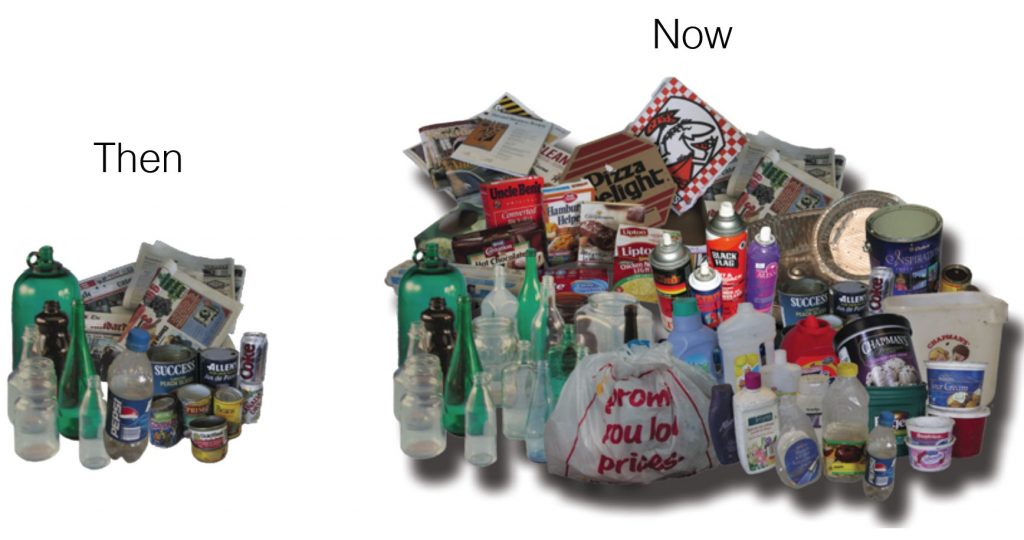TL;DR – BRA has always strived to reach a 99.9% level of purity in what they send to buyers. This was made all the more obvious by the recent proclamations by countries like China who are now accepting only incredibly pure shipments, and BRA has been mostly unaffected by those moves. However, many of the products BRA was accepting in blue boxes previously are either barely recyclable, or there isn’t a market for them, and therefore those items were often ending up in landfills. Instead of continuing to take on the time and expense of sorting products that ultimately will not be recycled, like Tetrapaks and milk/juice cartons, BRA is asking residents to place them in the trash instead. Styrofoam is an example of a material that can be recycled, but there has not been a viable market for it. That could be changing in the near future, but until then putting it (and other materials) in your blue box still results in it ending up in a landfill.
As Middlesex Centre’s representative at the Bluewater Recycling Association, I have had a few residents contact me, or reach out to their Councillor who in turn has contacted me, regarding some of the changes BRA recently made to its Acceptable Materials list.
The BRA released a lengthy blog post explaining the recent changes in great detail. You can find it here.

One example of consternation is aluminum foil. Dirty aluminum is not accepted by either BRA or the City of London, while London does accept clean aluminum foil. Foil plates are accepted by the City of London, but that doesn’t necessarily mean those items are being recycled given the purity levels now required by end markets. Therefore, a material being accepted by a recycling system does not always lead to that material being recycled.
When it comes to our recycled goods potentially polluting another country, as it pertains to BRA, this is not the case. BRA achieves at least a 99.5% purity rate on its bundles before shipping, as its customers warrant. To ensure it can consistently achieve this rate, along with all the other factors listed above, from time to time to accepted materials list has to change.
Ultimately BRA is doing what it can in a highly fluid environment based on markets for various materials, the prices being offered for those materials, the purity that can be achieved through sorting and cleaning, and so on.
When you compare our situation with that of many other municipalities across the United States, where those municipalities were taking complete advantage of the previous low purity acceptance rate by China. Now that China has upped its standards, lots of municipalities are simply shutting down their recycling programs. We are incredibly fortunate to have a team of people at BRA that are committed to a higher quality.
- https://www.wifr.com/content/news/Ogle-County-to-shut-down-drop-off-recycling-program-after-rising-costs-508920271.html
- https://www.cbsnews.com/news/recycling-after-chinas-plastic-ban-american-cities-face-recycling-crisis/

Thankfully many of BRA’s customers are located right here in Canada, as we discussed at a BRA board meeting in late fall 2018, but other factors still come into play.
Global News recently produced three stories, including segments and interviews with BRA staff, about the current state of recycling in Canada. Here they are in order:
- https://globalnews.ca/news/5199883/canada-recycling-programs/
- https://globalnews.ca/news/5207256/economics-of-recycling-canada/
- https://globalnews.ca/news/5207352/how-to-fix-canadas-recycling-industry/
You may be thinking that this shouldn’t be all about the economics of recycling, but doing everything we can to avoid material ending up in a landfill. I agree, it shouldn’t be all about the economics, however you’ll see in the first article that even companies taking the materials, including one in Stratford, are already at capacity.

Many people think that we, the residents, shouldn’t be responsible for directly paying for recycling at all, but that the cost should be borne by the producers of the goods and packaging we consume. After all, if a laminated paper product, like a clothing tag or coffee cup, can’t be recycled because of that lamination process, one would reasonably come to the conclusion that if the producers of those cups (the manufacturing company) were directly responsible for the costs associated with landfill diversion, it is far more likely that the manufacturers would find ways to produce high quality goods that can also be easily recycled rather than ending up in landfill. Instead, ratepayers are currently on the hook through municipally funded systems.
This other paradigm, extended producer liability, has been on BRA’s agenda for years. It has recently received some traction at the provincial level here in Ontario, but we don’t have any concrete timelines on when such a change could be finalized. Based on what we’re hearing at Association of Municipalities of Ontario (AMO) meetings, progress is being made but we don’t know when this will occur.
In the interest of full disclosure, I have uploaded a 200MB PDF to Google Drive. This is the full presentation provided to all the municipal representatives at our January meeting, including a lot of operational details, financials, awards received, how BRA compares to other recycling programs, and more.
Here’s the link to the PDF. It’s too large to view online, but you can download it.
Also, I collected a bit of information for a financial comparison.
For a home valued at $384,000:
Middlesex Centre
- Fee to BRA based on garbage bin size, I’m paying $100 (the smallest garbage bin)
- BRA’s per blue box operating cost is $56.60 per year
- BRA serves 150,000 people across massive territory, largely rural
London/Ontario
- London’s environmental services fees are estimated at $176.84 per household
- I called both the London tax office and Enviromental Services, but neither could tell me how much recycling cost per household
- Ontario average per blue box operating cost was $111.48 per year in 2017
- London serves almost 400,000 people in a much smaller service area
Lastly, I will let BRA President Francis Veilleux have the final word about the differences in materials BRA is accepting versus other systems. Where emphasis has been added, that is my doing, not Francis’.
“I can assure you that we have access to the same markets as everyone else. The reason others still appear to take the materials is because they cannot or refuse to tell the public the truth. It is too political.
The aluminum market now requires a 99.9% purity rate and this applies to everyone. Those who have foil, pie plates, food cans, and/or aerosols in their bales cannot sell their materials to the mills. They end up selling the bales to a broker or pre-processor that cleans the load of those contaminants before sending it to the end market. For that service they must sell their bales at a heavily discounted price.
Similarly, those with cartons in their mixed paper have found themselves unable to move their material so they have landfilled the material. We (BRA) have never had a problem moving our material. When they tell you London is better, I can tell you that we make a newspaper grade that we can sell for $88 per tonne. All London can produce is a mixed paper grade that they have to pay over $20 per tonne to get anyone to accept it.
Like others, we could accept those materials, spend a lot of money removing them at our processing facility to landfill locally and/or take a huge hit on the commodity revenue for someone else to do what we can’t do locally, and everyone would still believe they are recycling everything when in fact they are the source of the problem.
We believe in informed buying decision over offering smoke and mirrors for the sake of a better sounding political soundbite.”
I trust that answers all the questions people have brought my way. I understand some people are willing to pay more for a system like London’s, but I think the evidence clearly illustrates it’s arguable that their set up is “better.” BRA has 87,000 customers to satisfy, and I personally have over 18,000 to answer to on this matter. To that end, I don’t believe in spending money for the sake of spending money, especially if it doesn’t help or change the situation (materials ending up in landfill).
I feel that additional dollars spent by BRA should improve their ability to separate and purify materials that can then be sold for a reasonable rate, whether that rate is profitable or not. I hope we can all agree on that.
Thanks for reading!